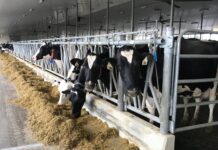[Music fades up, sounds of farm animals, tractors, computer clicks and digital noise]
Hannah Senior: Agriculture is one of humanity’s crowning glories; the ability to feed ourselves via a network of global, national and local food systems. It’s a foundational block critical to our success as a civilization – but at this point in our shared history, that very foundational block is looking shaky.
Economic imbalances, labor shortages, and the huge environmental impacts of agriculture mean that we’re on a path that is seriously unsustainable. Something has to change. And introducing new technology to agriculture might just help to steer us away from the otherwise pretty grim future, which we might be staring at.
In the first episode of this podcast, I explored why agriculture needs new technology. But turning technology from an idea into a product or service is not an easy process. And it’s one that’s fraught with risk and cost, which is one reason that entrepreneurs are an important element in introducing new technologies. And in this case, specifically, entrepreneurs that understand the needs of the global agricultural and food systems. But entrepreneurs don’t operate in a vacuum.
In this episode, I’ll be exploring how this route of turning bright ideas into changes in farming practice sits alongside other options like government intervention, or the innovation of existing companies already working in agriculture. I’ll investigate who’s involved in helping startups get off the ground, and why. We’ll also talk about something that’s become quite noticeable over the last couple of decades; that it’s become cool to be an entrepreneur. I’ll be asking where this aura of coolness comes from, and how cultural ideas we carry around with us about entrepreneurship can work for us or against us, depending on what we’re trying to achieve.
[Music and tractor sounds]
Hannah Senior: We know that lots of things need to be done differently in agriculture, and we also know that there are lots of challenges in the food system more generally. But how do we actually start to make these changes? That’s where entrepreneurs can make a difference. Entrepreneurs are good at spotting an opportunity for change, an unmet need, or a different way of doing things, and then acting on it. I spoke to Rasmus Hartman and associate professor at the Copenhagen Business School, about why it is that new technology and entrepreneurs go hand in hand so often.
Rasmus Hartmann: New technology rolls around every so often. Sometimes that technology creates an opportunity to create a lot of value. But it may also destroy the value of what an organization has historically been good at. If something is going to make the capabilities of your company obsolete, it’s going to make the assets that you have obsolete, established firms are less likely to engage with it.
A good example is Blockbuster. They took a long time to sort of get around to streaming for quite good reasons. One thing is they could look at and say “Well,it’s not clear that this is going to work out”. It seems totally clear today that this was the future. But back then it wasn’t really obvious. And if they had invested in it, it would have made obsolete, that whole network – all that real estate that they had would have become worthless. And all the skills that they had built up, all the routines that their organization had built up would also be worthless. Their business model would be undermined.
The other thing is that innovations that target new markets, or markets that don’t yet exist, that seems to also be something that entrepreneurs play a disproportionate role in. So Airbnb is a good example here. There was no real market, there was no market to be analyzed, so to speak, for going places and living in people’s houses. It was very difficult to assess the value of that. And so it makes sense for entrepreneurs to engage with this kind of thing. And then it turns out to be true, but there are very many versions of the world where Airbnb doesn’t
become a thing. Those are two examples of things that entrepreneurs usually undertake that others don’t.
Hannah Senior: Juliet Ansell, from Zespri International, also echoes Rasmus’s thoughts on entrepreneurs:
Juliet Ansell: They’re often very single minded and passionate and I think they see things that other people don’t see. It’s having people that can see something, can see a need, can see a solution that works. But they’ve got the passion to keep going when everyone else is just like “Nah, that’s not important” or “We don’t need that yet”. So they definitely play a role. You wouldn’t get this with normal university researchers, or with the industry research going on.
Hannah Senior: Agriculture itself is hugely diverse; crops, climate, soil types, philosophies, and so on. This creates segments and opportunities that an entrepreneur can spot or choose to tap into that large corporations might not. In recent years, we’ve seen advancements of radically different ideas starting to shake up the food system, such as the introduction of synthetic meats, or advancements in vertical farming. But notwithstanding all the noise, these are still very small steps when thinking on a global scale. These innovative companies are minnows alongside the corporate giants of agribusiness, who spend collectively billions of dollars annually on R&D, especially in highly regulated areas such as biotechnology and agro chemicals. Expecting startups to be the main cause of change in the food system would be a mistake.
We can imagine a world in which industry disruptors like Airbnb or Netflix didn’t happen. But imagining a world in which we don’t get the changes we’ll need in the food system will eventually create much more grievous problems than fewer vacation rental options or having to go to the video store. In order to make real and significant change to the global agricultural and food systems, we’re going to need everyone in the system taking action – including the multinational giants.
So who else needs to play a part? Researchers and academics have an important role in bringing breakthrough innovation to industry sectors. But being a scientific researcher takes a very different skill set to being able to operationalize and build a business or service off the back of that research. Governments could also provide funding and support for both fundamental research and translational outreach. But it, too, can’t bridge that gap between research and a market ready product.
So back to existing industry giants. Change in large scale companies is always risky, even if there are new and profitable business opportunities and a healthier food system for business, people and planet. But the way in which the Ag giants are engaging with startups and innovation, research and development is changing. And this will likely be part of the paradigm shift we need. Entrepreneurial solutions frequently grow from smaller companies, which might be for profit or not for profit. But to effect significant change in the global landscape is the interplay between these smaller, often more localized companies and the agro giants that needs to be considered.
Agribusiness veteran Adrian Percy spent many years in the research and development functions at Bayer, UPL, and the wider agri tech R&D world. He notes that although it’s slow, change is coming. Because of the very nature of agriculture, new businesses often have really long development times before any end result can be seen. And he’s noticed in recent years that this is where agri giants are starting to play a more significant but historically very different role.
Adrian Percy: There has been quite a shift in how agribusiness and particularly those large companies that you mentioned, are working now with these smaller companies. In the past, I would say most of their activity was centered on their own R&D, their internal R&D, which was done in a highly efficient way, but was limited to only a few technologies that they really felt they could bring to market. I think now, what has changed is that first of all, we’ve seen through consolidation, a decrease in the output of those companies in terms of that basic R&D
activities that they’ve had, they’ve adopted a more, what I would call an open innovation model. So they’re trying to work with many of these companies at a very early stage. And some of these companies actually are investors themselves. So you know, many of them now have their own corporate venture capital structures, and they’re making investments, making a number of bets, if you like, in the hope that they will kind of unveil the next transformative technology.
But as as these technologies are moved through in the development cycle within these small companies, they are tending to partner with these larger companies where they can, and that’s partly because of the expense of developing these new technologies, all of these field trials that we talked about earlier that have to get done mean, these are a very, very heavy expense for a smaller company to kind of bear. Plus the long development cycles as well, which can be, again very, very hard for a company with a limited runway to actually bring a technology to market.
So, I think many of these companies see a great model for them is to work in partnership with the larger companies, get investment from them, but also work to each other’s strengths. So, many of those large companies have very, very broad development platforms, field trials, stations all over the world, regulatory people all over the world. Whereas the smaller companies may have a unique research focus, which makes it very attractive for the larger companies to want to work with them.
Hannah Senior: This is not a new innovation model. It’s widely seen in pharmaceuticals; a company will start perhaps with some new innovation derived from a university research team. This idea is developed and evidence is collected to prove its effectiveness. And at some point, it becomes attractive to be invested in or acquired by the big companies, which also presents the perfect exit for the entrepreneur.
But what if a new venture doesn’t want to exit by selling to an agri giant? What if the company is developing a solution that’s perceived to be too small, too niche for the agri giant’s to be
interested? Or what if the startup doesn’t fit with the current business activities of the acquiring company? Like in the Blockbuster example, we touched on earlier? And what if it’s a whole new market altogether? I asked Adrian Percy for his thoughts:
Adrian Percy: The ability to exit to a large corporate partner is quite limited, because there are only five or six which play at scale in the industry right now. There are a number of smaller companies, but the ones that are really driving this you can count on one hand. So that does mean that companies, if they don’t want to go or their technology is not suitable for exiting via one of the major companies, they have to go another route. And you are seeing companies trying to do that, developing new business models going directly to farmers and not necessarily through the large companies or through the distribution chain. You’ve seen new companies which are creating new distribution models in a more digital type of space than we’ve seen previously.
So I think companies are trying to get creative and imaginative. They’re looking at what has been done in other sectors to try and learn from there. And then try to apply, deploy, new business models so they can get to new areas. But there are also some completely new areas, that didn’t exist before.
Indoor agriculture: of course we know about greenhouse production, but really true vertical farming is a completely new area where you’re seeing a lot of investment, and probably the biggest area investment in the last couple of years. You’re also seeing alternative protein production, which again, is very different from what the large agribusiness companies have focused on, they focus more on calories, perhaps than protein in the past. So there is an opportunity there to create new markets with new types of companies. So we’re seeing some of that as well.
Hannah Senior: So, we know we need entrepreneurs, and we know we need change. But as with all things, it’s never simple. And for entrepreneurs in the AgTech space, this includes
navigating yet another system beyond the complex world of the food system that they’re already working in.
Young ambitious companies need access to finance as well as access to business networks and opportunities. And it’s another system entirely that they need to master and understand in order to achieve their goals. They need to navigate the entrepreneurial industry and the entrepreneurial ecosystem.
[Music and farm sounds]
I’ve said it before, and I’ll say it again: agriculture is diverse and complex. What works for one farmer may not work for another farmer. What works for one crop may not work for another crop. It’s that diversity of needs that makes the problems facing modern agriculture so difficult to address, and the solutions to them similarly diverse. So if we need a variety of solutions, does it make sense to look to just one model of entrepreneurship to find them?
Now it might feel like we’re veering off the path of AgTech at times in this episode. But it’s really important to understand where we are in order to know how to get to where we need to be. If we need entrepreneurs to help change the way in which the world’s food system is functioning, we need them to be successful. We need to create an environment that’s broadly beneficial for the entrepreneurs themselves, the farmers and the society they work within.
But just as agriculture is diverse, so are entrepreneurs and the ventures they create. And yet at this point in time, we tend to have a very specific idea of what a successful entrepreneur looks like. And that’s something we need to understand before we can discuss questions of change.
Take a moment to consider what you think a successful entrepreneur’s story would be. Could it involve a college dropout working in their mom’s garage? Or perhaps a down on their luck nerd creating a unicorn startup and overnight success? Yeah? Well, this could be part of the problem facing AgTech. When we think about entrepreneurship, our contemporary mental model is heavily dominated by the likes of Mark Zuckerberg, Elon Musk, and Jeff Bezos. It’s
hard to underestimate the extent to which this shapes the prevailing view of what it means and what it takes to be an entrepreneur. Starting and running any business is difficult. But contemporary society has put the Silicon Valley model on a pedestal as “ideal” entrepreneurship.
So let’s unpack what exactly the Silicon Valley model is. And that involves the history of where this model has come from. We need to unpack, too, the idea of the entrepreneurship industry. And the idea of a unicorn company, the promise of starting a business that comes to be valued at $1 billion, creating untold wealth all around. Let’s look at history first. Why is it that the Silicon Valley model is so influential to contemporary entrepreneurship? I asked Rasmus Hartmann at the Copenhagen Business School to explain it.
Rasmus Hartmann: So every time there is a major new technology cycle, there tends to be a leading country in that technology cycle. The UK was at the forefront of a lot of the technology cycles that became the Industrial Revolution; development machines, factories and canals, then later steam, coal, iron and railways. It was something which was driven initially from the UK, but in the wave that we’re currently in the US has been a leading country. So it’s natural to look to the US for a model of how new firms develop.
There was a time when people would go to the UK, to Manchester, to see “What is this factory thing?” And today, if you want to understand what it means to have a tech company, an IT based company, the natural place to look is to the west coast of the US. And so, as has been the case before, there’s sort of a particular ideology around entrepreneurship, technology innovation in those leading areas. I’m sure if you’ve gone back to Manchester, or London, you would have seen a very particular ideology around what we are trying to do. Like how does one become a great entrepreneur of the Victorian variety? Right? And the same way there’s sort of a vision of “how does one do this?” How does one build an IT company in the Silicon Valley mold, and I think that’s obvious if you both are looking from the outside in. And also if you’re in Silicon Valley, there’s a high level of self consciousness around this. And so the rest of the world looks to Silicon Valley for this.
Hannah Senior: It’s well understood that there are some important ingredients in the development of Silicon Valley, which we’ll come back to over and over again. These include massive amounts of government research spending, primarily in connection with defense, which led to new technological breakthroughs and an accumulation of people with plenty of skill and experience in engineering.
Another factor is the development of successful spinout companies, which made many founders and backers very wealthy. Then, there is the emergence of the venture capital model of investing in startups, which also emerged from Silicon Valley, offering those very people high risk, but high return investment opportunities. This led to a gold rush of sorts, where our computing and IT capabilities were expanded, and electronics capability developed, birthing the computing industry, which then gave rise to software and the internet.
The romantic notion of the inspired genius entrepreneur, which the economist Joseph Schumpeter was so influential in establishing, received an extra boost by being connected with the idea of the college dropout in Silicon Valley, who became a billionaire. The location of this wealth creation and innovation in California also allowed this model of how to be an entrepreneur to borrow from California’s branding, which helpfully includes glamor, counterculture cool and lots of sunshine. Rasmus Hartmann recognizes that the influence of the blitzscale technology business-like approach is pervasive. But for many entrepreneurs and their businesses It’s just not a model that works.
Rasmus Hartmann: Of course, the downside is that model doesn’t work for everyone. It’s a very particular model that probably gets over generalized way too much, to the degree that it obscures that there are many ways to pursue entrepreneurship. And there are many ways to come into entrepreneurship. And there are many strategies for an entrepreneurial company, even if it’s growth oriented, and wants to be a big company and a very valuable company – there are many ways that you can do that. But everybody seems to be looking to Facebook,
Google, Amazon, for the playbook on how to do this. And that is just horribly bad reasoning, I think on a whole range of counts.
Hannah Senior: One of these counts Rasmus is referring to is that the success of businesses using the Silicon Valley model of entrepreneurship frequently involves venture capital investment, which with agriculture’s unpredictability of outcome and long production cycles rarely aligns that well. I’m going to talk in more detail about this in Episode Five. This model of “ideal entrepreneurship” was also built around digital technology; predictable, repeatable and binary. In the Silicon Valley idea billionaires are made, apparently, overnight, but AgTech on the other hand, involves not just technology, but also biology, ecosystems, genetics and weather, to name just a few of the messy, unpredictable factors. It’s physical, tangible, and it can take decades to research and bring a product or service to market.
Another big reason to consider is that the Silicon Valley model is heavily reliant on the go big or go home mentality; the need to be the biggest, the best and to dominate the globe. This might work for businesses in massive markets, such as commodities. But as we talked about in episode one, we’re going to need global national and regional solutions to change the food system. The more specialist solutions are the ones that operate not at the scale of vast global markets, but by addressing the needs of specific countries or crops or specialty areas. When I’ve discussed this with some people, a remarkable lack of nuance can arise. It seems that the conversation often flips from “ambitious unicorn track go-getters” to “part time hustle” or “lifestyle business” with seemingly nothing in between.
It is entirely possible for a company to be hugely successful, highly profitable, and influential, without it aspiring to being a unicorn, or blitzscaling its growth. Indeed, it’s also possible to be an ambitious, fast growth tech company with a $1 billion valuation without being born of this type of entrepreneurship and mindset. And that is precisely the point. The real world doesn’t and doesn’t have to match our mental models of what “good” looks like.
So who is pushing this idea of the VC-funded “Go Big or Go Home” model as the best entrepreneurial approach? Again, there is no one overriding factor. But a major contributor is the entrepreneurship industry, which has sprung up riding the coattails of Silicon Valley,
Rasmus Hartmann: An entrepreneurship industry is an amalgamation of firms that sell goods and services to prospective and current entrepreneurs, with the aim of helping them execute on opportunities. It’s all about the specific goods and services that entrepreneurs can buy, in order to try to do better and there is a range of different examples. One of the big things is legal and administrative services, targeted at entrepreneurs; expos – like the settings where entrepreneurs can congregate. There’s an industry supplying that. There’s a media industry around this; books, magazines, speaking events, and lots of podcasts directed to entrepreneurs, giving them advice, essentially, and gossip about what’s going on in the ecosystem. So there’s a whole bunch of different things.
Hannah Senior: If there is a large and successful industry feeding off entrepreneurs aspirations, of course, it’s going to dangle the most successful and lucrative examples in front of new entrepreneurs as proof of success in relation to their product. To present too much failure or risk threatens the industry’s very existence.
Rasmus Hartmann: In order to be an entrepreneur, you have to get comfortable with failing. I think that’s a valuable thing, generally. If people are very risk averse, they certainly need to be open to the possibility of failure if they want to become successful entrepreneurs. But that’s of course not the same as saying that failing is good. The history of Facebook, the history of Google, the history of Amazon is not a History of failure, right? It’s about the paranoid desire not to fail, once you’ve proven out a concept. But if you think about it along those lines, you would also think, well, what is the entrepreneurship industry doing?
Well, it’s a little bit like a drug dealer, in a sense, right? It is presenting a product and getting people to use that product; forces the industry to re-educate people, getting them to like these things. And of course, if you think about the economics of the entrepreneurship industry, along
the same lines, the sort of insidious metaphor is that you need users, you need a lot of them, you also need them using more – not so much that they die, because you need them to use for a long time. You need people to consume this stuff, go to the events, buy the books, buy the services, you need them to do it often. And you need them to stay in it. You need them to be persistent in their ventures.
So whenever somebody is telling you that this is the stuff you need to succeed, and you should definitely stay in your venture and be persistent, you should think about that, from the point of view that they have specific incentives operating on them, which are not unlike, perhaps those of drug dealers.
Hannah Senior: On the topic of consumption, another factor that Rasmus raised in connection with the Silicon Valley model, and that travels hand in hand with the entrepreneurship industry, is the idea of the Veblenian Entrepreneurship. I’ll let Rasmus explain:
Rasmus Hartmann: So Thorstein Veblen wrote a book called The Theory of the Leisure Class, which talks about the idea of what’s called conspicuous consumption: consumption that doesn’t serve a functional purpose, but that’s meant to be ostentatious. It’s meant to be some form of consumption that you do in front of an audience in order to rise in social esteem. So you can think most of us would be fine with very simple cars to get around. But yet there is a market for Ferraris, and Porsches and things like that. And what characterizes Veblenian goods, in the micro economic sense, is that they get more in demand when the price goes up. Champagne is a good example. Champagne is wonderful. But the fact that Champagne is so expensive, makes it more desirable.
We usually think about the entrepreneurs being all about production and growth and their venture and having an impact on the world. Whereas the Veblenian Entrepreneur is much more interested, we suggest, in the identity work of being an entrepreneur, the ability to tell people and tell an interested audience: “Look at me, I’m an entrepreneur”, instead of producing
– which is what we usually think entrepreneurs do.
There was a sense that entrepreneurship was something that had just become a little too cool for its own good that it had become something that people just love to tell other people about. There’s this phrase called “Doing it for the ‘Gram”; doing something to get it on Instagram. And so that was sort of a metaphor that came up for us. There seemed to be a lot of Instagram entrepreneurs.
Hannah Senior: Why is this a problem? That entrepreneurship seems to be so attractive that it’s luring in people for the status rather than to create meaningful companies? Well, it makes it harder for everyone to tell who’s serious and who’s less serious. It lowers the average quality of entrepreneurial ventures, which means investment gets misallocated, and it may eventually even deter serious, credible people from wanting to pursue this path.
I’m going to take this opportunity to say that the goal here isn’t to go bashing successful Silicon Valley style entrepreneurship. This is a model that does work for many businesses. But what I’m focused on is AgTech entrepreneurship. Being aware of the mental models we’re using is super helpful. Because there is no particular reason to think that all the formulas for success that are proven for software or computing companies will also be formulas for success in AgTech. And yet, we often borrow heavily from the same playbook.
Whatever model of entrepreneurship you use, no startup is an island. And this is where the concept of the entrepreneurial ecosystem comes in. So let’s explore that now.
[Music and farm noises]
Hannah Senior: To create a new business requires interaction with dozens of other people and organizations in the “entrepreneurial ecosystem”. Let me explain. If we think of a natural ecosystem as a combination of the organisms and the environment they interact with, that is the biotic and abiotic forces influencing their interactions. Then the entrepreneurial ecosystem is made up of lots of organizations and people interacting and pursuing their own ends under the influence of economic and social forces. Instead of energy flows and predation. We have
financial flows and information flows. And instead of insects, birds and plants, the entrepreneurial ecosystem may include universities, investors, legal advisors, and workspaces. To have a thriving and entrepreneurial AgTech scene, you need a thriving ecosystem for it to exist in.
So who is involved in the ecosystem for entrepreneurship in agricultural technology? To name some of the important factors, we have entrepreneurs themselves, government at national, state and local levels, universities and research organizations, companies already in the industry, consumers, investors and financiers, farmers, and organizations geared specifically to helping entrepreneurs such as business accelerators.
We spoke earlier about the dominance of the Silicon Valley model of entrepreneurship in relation to computing and software, and how the area became the perfect ecosystem for new companies in these domains. But in AgTech, other regions around the world are starting to make a name for themselves in innovation, entrepreneurship, and agriculture, because they’re creating an ecosystem where new ideas and agricultural technology can flourish. They’re getting the balance of all the necessary components in place. Adrian Percy, an AgTech Research and Development veteran told me what he’s seeing around the world in terms of ecosystem development:
Adrian Percy: The first thing to say is that we have many hotspots around the world where we see hubs of activity. And that’s really exciting. You can look at places like Israel, where food security is, for obvious reasons, a very big deal. And they put a lot of effort into supporting new technology in agriculture. But you also see other areas like New Zealand, Australia, where there was a lot of activity in this area. South America is busy now and we see more and more activity in Brazil, Argentina. Europe has always been with a strong university system, strong agricultural base. Here in the US, it’s very much capitalist and investment driven. Luckily, the universities and, of course, NC State, is very open to public private type relationships and looking to deliver impact on the farm through even quite commercial type activities. Whereas
you see, perhaps in other parts of the world, more government support and government incentives that are being provided.
Hannah Senior: So to create a thriving AgTech entrepreneurial sector, we need all of these components, government, commercial entities, research organizations, etc, to align with the needs and strengths of an entrepreneurial ecosystem. I wanted to know more about the kind of work that’s being done in these AgTech hotspots around the world. Sarah Nolet, is an internationally recognized food systems innovation expert and the CEO of AgThentic, a global food and agriculture strategy firm based in Australia. I asked her what she felt were important elements in creating an entrepreneurial AgTech ecosystem.
Sarah Nolet: I mean, I grew up in Silicon Valley. And I saw and lived the experience of entrepreneurs who would get an idea, and then they would create it, and then they would get funding and then they become successful. And then once they left the company they founded, they would become that next wave of investors backing that new crop of entrepreneurs. And so you had this reinforcing cycle of talent and experience with building businesses and capital that could flow in.
That is such a critical factor in ecosystem, because you need people, you need capital. And yes, you need the ideas and technologies. That’s all absolutely critical for agriculture. And so we really have a bunch of different components where we need users, we need the value chain, we need risk appetite, we need different forms of capital at different stages of the innovation journey. And we need these different perspectives to come together in both structured ways, as in “here’s a program” but also unstructured ways like building networks and communities so that ideas can flow and so that you have serendipitous connections that maybe two years later becomes a podcast or becomes a hire for a new company. It’s a lot of that qualitative and people dynamics that make the ecosystem flow. And today, we do a lot of that remotely as much as in person, which has, I think, broadened the scope of who can participate in AG and AgTech.
Hannah Senior: Sarah also noted that a shift in government and institutional priorities, has given rise to a robust and growing AgTech ecosystem in many countries.
Sarah Nolet: So there’s individuals who’ve been on the forefront of this and willing to go out there and try new things and talk about it. Then there’s been, at the totally other end of the spectrum, institutional support in the form of governments – and this is increasingly true. Seeing that agriculture innovation is a priority for them, whether that’s from a food security perspective as in “we need to be more food secure in terms of what we produce”, or an innovation possibility like with Israel, sort of seeing that they could be a technology exporter to the world. Or Australia is thinking a lot about technology to improve productivity and increase the amount of food and fiber output, but also potentially as an export opportunity in its own right, you know, selling products and services to the rest of the world. And so that’s led to government support around early stage innovation, like incentives for venture capital funds or incentives to do trials or rebates for farmers to access a new technology, or events where farmers and startups might connect or showcases where products are easier to access – and they have reviews about them. So there’s a whole range of ways on the kind of grassroots end and the government/ institutional end and everything in between, that have been really critical in kind of catalyzing a lot of this work.
Hannah Senior: Juliette Ansell, of Zespri International, echos Sarah Nolet’s thoughts about institutional and government support being a major factor in building a successful startup ecosystem for AgTech. And that, in turn, is encouraging and retaining a skilled workforce.
Juliet Ansell: Living in New Zealand, I’ve realized how important agriculture is to the country. Our economy is based on the primary industries. And I think for that reason, everybody’s really aware of it. There’s really good investment and awareness from the government. And certainly over the last five years, I’ve seen a sort of huge increase in the attention and funding that agritech is getting. I’d say that there’s a really healthy attention on it from the universities and the research institutes, because I suppose they want to attract government funding and private
commercial funding, and it’s really important to the country. So there’s good capability, but the best researchers, from a kiwi fruit perspective, are definitely here in New Zealand. We’ve just had an international conference, actually, I think on just on kiwi fruit, and that shows how the rest of the world really looks to the R&D that’s been done here on kiwi fruit.
Hannah Senior: So what can help to foster a good ecosystem? It is something of a continuum between a model which is heavily government driven, often because of the importance of agriculture to the economy, for example, in Ireland or New Zealand, and a model that’s heavily driven by the investment opportunities and all the activities of major multinational agro businesses, like we might see in the USA.
Juliet Ansell: So I think a lot of it is connecting, putting pieces together; having networks where people know each other, but then there’s the global scanning piece as the who’s who’s on the lookout for all these new things. How are we catching these new things? That definitely becomes easier in the connected world today. Because we can find out about what’s happening around the world now – just at our fingertips, but you still need someone to devote time to that. And that’s something that happens really well here in New Zealand is there lots of people looking on behalf of industry and researchers and the companies.
Hannah Senior: Adrian Percy echoes Juliet’s thoughts. But note that the consumer shouldn’t be underestimated.
Adrian Percy: Consumers have a big role to play here. We see very different attitudes in the West, even within countries in Europe, for instance, towards agricultural technology; wholesale rejection of some agricultural technologies by consumers, by governments, whereas in other countries, we’ve seen them being embraced.
Hannah Senior: There are a lot of elements in an ecosystem. But often what helps to bring these elements together and start meaningful interactions which help new ventures flourish, is an organization designed for that purpose. Across the entrepreneurial world, there are many different models to do this, venture studios, incubators, pitch competitions, all offering slightly
different combinations of incentives and support. But either way, there has been an explosion in the number of these events and organizations focused specifically on AgTech, as innovation in this area has gained momentum over the years. Some provide workspaces or lab space, some offer training to develop entrepreneurial skills, and others create opportunities to catch the eye of investors. In this next section, I’ll refer to them broadly as business accelerators.
[Music and farm sounds]
Hannah Senior: A business accelerator is an organization or program set up to attract young companies with a founding team and some sort of momentum in order to help them grow or launch faster, or be more successful. Participants are often selected in a competitive process forming a group or cohort. And they frequently run through a somewhat structured program for a period of months that aims to speed up the company’s development and achieve certain key milestones, such as testing the product-market fit of the idea, or gaining their first paying customers. But business accelerators are not typically great profit centers. Startups have no money to pay for services. And while it’s fairly common for shares in each participating company to be given in exchange for participation, the risky nature of startups means this frequently turns out to be worthless. As such, business accelerators tend to be started by interested parties who have more incentive to get close to these businesses. For example, professional investors in startups – venture capital firms – may start a business accelerator to create deal flow and learn more about companies and their teams prior to any investment. Large Ag companies may start to keep an ear to the ground about new technologies. And as we mentioned earlier, this may result in investing or partnering with innovative new businesses, or a shift in response to market signals.
Governments on the other hand, may launch business accelerators in order to develop a strategic advantage for a country or region with the hope of creating high growth businesses on home turf, and investing in innovation. New Zealand’s business accelerator, Sprout, was originally set up to build on the country’s strength in the primary industries, bringing together government ambition and private sector companies. I spent time with Sprout and spoke to
many of their corporate partners in New Zealand; big successful corporations, who nonetheless often describe themselves as being too small to be able to keep abreast of all areas of innovation, or justify their own venture capital arm. But by banding together, they can learn from, benefit from and support startups with new ideas. Juliet Ansell at Zespri International has been involved with Sprout for a few years now, having been approached by the business accelerator because of Zespri specialty knowledge in the horticulture industry and hence ability to gauge the potential of a startup in that area.
Juliet Ansell: So the Sprout basically invites applications from anyone, any startups, to apply for an accelerator program here in New Zealand. And they have industry panel and venture capital panel members who do a bit of a “Dragon’s Den”. And so I went along, and we have these “selection days”. The first year I went I think they had maybe 200, they whittled down to
25. And then each comes in and pitches. And we’d get down to maybe eight that go through the accelerator.
I mean, one of the really good things about it was, first of all, it’s fascinating! It’s interesting, even the ones that are not in the horticultural space, I think it keeps your science mind alive. I enjoyed it for that and for meeting other people on the panel. So meeting my counterparts in Fonterra, or LIC, or, you know, the other big companies, you can swap ideas about how you do innovation or what challenges there are. And then we get to follow them through the process – if they’re developing something for horticulture, they can come and meet my team or go out on orchard, or I might see something that they did develop for horticulture think “Oh, that would really help us with this problem we’ve got over here.” The way that Sprout works and is set up I think is very close to industry. It’s trying to nurture the startups through and end up with a product that’s better than it would have been without that accelerator.
Hannah Senior: Another example is Thrive, which now has accelerator activity running globally. Thrive began when the entrepreneur turned venture capital investor John Hartnett, connected with growers in California’s highly productive Salinas Valley, in the hope of bringing Silicon Valley innovation to the horticultural growers in the region.
As the Accelerator has expanded internationally, it’s tapped into the different motivations in different geographies. Both of these business accelerators are mostly focused on supporting for-profit companies, with the hope that one or many will grow and flourish into large and profitable organizations. They’re optimizing for economic growth and creation of valuable companies. But just like the food system itself, change will come from a diversity of approaches. As we explored in Episode One, we don’t just need new technology, but also change in the social, environmental and political landscapes around agriculture and the food system.
I spoke to two founders of business accelerators that recognize that broader change needs to be approached in different ways.
Peter Herz: Social innovations happen very often, starting in the nonprofit world, and over time, expand into businesses that are for profit, too. So there are some really interesting early signals in the nonprofit world that we felt was important to track and to support because there are a range of changes that needs to happen across the food system. Some of them are absolutely for-profit, viable opportunities. Others may actually be best served through a nonprofit. And so we believe supporting innovation across both for profits and nonprofits is a key way to have this larger systems impact that we’re trying to have.
Hannah Senior: That’s Peter Hertz, an engineer turned entrepreneur and investor. After an eye opening doctor’s appointment, a personal health journey led him into a lengthy exploration of world food systems, where he saw a drastic need for change. To tackle that, he recognized he needed a new approach. He launched the business accelerator Food System 6, in an effort to support social change, as well as business and innovation across the food system.
Peter Herz: We decided that looking back, this is in 2014, that the support that entrepreneurs had in, let’s say, in IT where I used to be, is rich; you can get support to start a new business in the tech world, not just in Silicon Valley, where I am based, but really all over the world. But we found that the support for innovation in food and agriculture is much thinner, and is remarkably
small, given the scale of the food system, which is between one and one and a half trillion in the US and five to 7 trillion globally. And so we didn’t see the kind of support, to help these entrepreneurs be successful, exist at the time. And so we decided that we would build an accelerator to work with entrepreneurs, and that is Food System 6. And we work with both for profit and nonprofit innovations in the accelerator, and itself is a US 501(c)(3) educational nonprofit because we decided the best way to support entrepreneurs is through a nonprofit vehicle.
Hannah Senior: Peter wants his accelerator to be an engine for change in the food system.
Peter Herz: In the food system, environmental Health is very important. But we always also wanted to address social health and social justice. And we believe that these are all interconnected. And if you have people where you have concentrations of wealth, you can arrive at systems that are pretty corrosive. The fact that we don’t have good social justice, and we have not democratized wealth, allows for a lot of the industries to, you know, provide food that actually does not nourish us and to extract from the environment the inputs to that food system that also won’t serve us in the long run.
Hannah Senior: Another innovator, Pete Nelson, is a farmer turned founder of the business accelerator AgLaunch. Based in Tennessee, the emphasis of AgLaunch is very much centered around farmers, and how to make a real difference to their businesses and communities.
Pete Nelson: AgLaunch is a nonprofit organization. We have a sister organization that’s essentially a farmer Co-op. It’s a limited liability company owned by farmers, where we do a lot of the actual business transactions. The nonprofit has funding from the federal government, state government and philanthropy in order to create a better environment for farmers to position themselves into what we see are future opportunities. And that’s around measured sustainability, monetizing ecosystem benefits, a broader range of crops that are being valued based on nutritional density, and not necessarily on sort of a commoditization. And the other sort of aspects that go along with that.
Hannah Senior: Both AgLaunch and Food Systems 6 recognize that change to entrepreneurial infrastructure and ecosystems is essential for AgTech startups and entrepreneurs to thrive, presenting opportunities for the much needed changes in the food system to happen. This often means not necessarily backing the most lucrative horse, but the horse that can best drive the change needed in the industry.
Pete Nelson: How do we get farmers moved into more sustainable practices, more profitable practices that position them to move away from the commodity based agriculture we have now into a more innovative production base? Ultimately, as an organization, we believe we have to build a new type of infrastructure to support Ag innovation. Typically, what’s happening in the United States is the supporting infrastructure, meaning accelerators/ incubators are either what I guess you would call a Silicon Valley model: the “fail-fast”, “how do we launch stuff?” “How do we get big feedback loops quickly?” with very little understanding about how small and tight the agricultural community is. And so often, building it like a software company doesn’t work.
The other model that’s prevalent here, I would do more like the pharmaceutical model: very urbanized, heavy regulatory barrier, huge capital cost of market. Both of those innovation models don’t work for the things that we believe are going to be the future of agriculture. Those would be targeted biology, and using machine learning, and artificial intelligence, and all the things that go around with data, and how you couple those things together. So our system is fundamentally different, because our incubator, if you will, is a network of farms. And the way we scale is creating feedback loops across multiple soil types, crop types, to help grow and commercialize the companies that’s expensive. That’s work that a startup company would not be able to fund for themselves. It also, by nature, sits outside of the corporate driven models that we have in the United States right now around innovation.
Hannah Senior: Business accelerators can be extremely valuable to a startup company, irrespective of the form that it takes. The ability to network within a cohort of other businesses, gain access to experienced business, veterans and potential investors, and take time to focus
on development of your company are all vital to the success of a startup. But it may be that we’re reaching a point of oversupply in AgTech accelerators, which hints that we might be approaching an important concept I’m going to talk about now; an unstable boom in the innovation cycle.
[Theme music fades in and out]
Hannah Senior: Investment in agricultural technology has risen rapidly in the last eight to ten years. AG Funder, a research and news organization in this space, estimates that global investment in these companies working in “upstream agrifood investments”, broadly, pre-farm gate has risen from $2.5 billion US dollars in 2012 to nearly $16 billion US dollars in 2020. So where does this go next? Will it increase forever?
Carlota Perez is a well known economic historian who studied technological revolutions extensively. She describes how financial investment in new technologies often follow a very predictable pattern, where an emerging technology erupts and financiers who are backing it fall in love with it. Initial successes drive more enthusiasm for the sector, and greater risk taking as really good opportunities become scarcer on the ground and the levels of hype increase. But at some point, the bubble becomes so inflated that it bursts, resulting in regulation, rethinking and “retreat to investing in the production economy”.
The new technology is not likely to be abandoned, but it is less than the original hype would suggest. Will this kind of cycle before AgTech? Rasmus Hartmann, Associate Professor at the Copenhagen Business School, considers that a boom-bust cycle is just the nature of the beast, but more awareness of the hype, and the likelihood of a boom developing, which will then peak is what’s needed.
Rasmus Hartmann: To have these new technologies roll around and create opportunities for entrepreneurs and established firms – that, sort of… There’s an initial period where this new technology is tested out, or sometimes to create these very positive effects. And that then leads to a period of frenzy where more and more people think that there are opportunities to be
had beyond the narrow spaces where technology is initially applied. And that creates people surging in at the same time, those initial successes will both mean that there are people who have money to invest because they’ve been successful. And it will mean that there’s a financial industry that can look at that and say, “oh, there are huge gains to be had here”. So you have sort of the perfect storm for people to surge into the industry and for capital to come in, wanting to take risks. And that often creates a period of frenzy, invariably, that leads to a bust because asset prices get inflated and the real economy sort of separates from the paper economy. Everyone is speculating on the asset instead of actually the dividends that come from that.
But in that account, you can’t really have tech booms without the bust and you need that boom for the technology to get in and get traction. So you need the hype around AI in order to have the money come in, have the talent come in, to do the exploration, but then there are going to be misses and there are going to be more misses perhaps than would have been socially optimal, but they’re sort of inevitable and you can’t have a major change in the agricultural sector without having some busts along the way. Whether you could cool it down. Well, I think this awareness of course, matters a lot, right? And getting people aware of the hype cycle and telling them “there’s way too much hype here”. Some hype is necessary, but that much hype, maybe not so good. But in but really understanding, you know, the “rush” part of the gold rush.
Hannah Senior: As always, judging when the peak will come is a fool’s game. On one hand, we have arguments for continued investment, the fundamentals of feeding more people and the changing planet, opportunities for big improvement in productivity, and investor interest in environmentally focused projects. And yet, on the other hand, is the risk that investors, much like they did with clean energy investments in the noughties, may decide that they’re just not getting the returns they want fast enough, and will focus their efforts elsewhere.
There are things we can do to try and head off the worst effects of a crash, and ensure the underlying development of agricultural technology and practices continues. In particular, we can be more aware of the hype stages of this technological revolution. We can recognize and be appropriately suspicious of that idea of Veblenian Entrepreneurship. And we can be more
open minded to alternative models of being an entrepreneur. These are all parts of this puzzle. The trick we have to focus on is how to ensure that when the correction comes, there are enough good, viable companies and activities in the ecosystem to keep the momentum going.
[Music and farm noises]
Hannah Senior: Entrepreneurship is a really important part of turning technological advances into on the ground changes to the way things are done in agriculture. It’s always risky, but successful entrepreneurship is made more likely, if there’s an ecosystem with lots of other people in the industry buzzing with exchanges, information, enabling trials, and if there is access to risk capital. This doesn’t just help the entrepreneurs, it enriches everyone else in the ecosystem, from farmers to incumbents to inventors. As with a natural ecosystem, diversity is key. It’s important to remember that everyone is pursuing their own goals. And so identifying and aligning with people who share your goals and values is also important, be it existing companies trying to grow market share and competitive advantage, investors trying to maximize returns, or farmers trying to maintain and grow profitability. There is no wrong party. But everyone is working within the existing system. And that won’t necessarily result in better outcomes to address those social and environmental issues we discussed in episode one.
Although entrepreneurship matters, we need to be super careful of the ideas we may be carrying around with us. The model of Silicon Valley success shapes our thinking a great deal. It has many virtues, but sticking too rigidly to a model that worked in technology in California, etcetera, could be a dreadful mistake. We should also be cautious of making entrepreneurship too cool. Whatever the entrepreneurship industry tells us, it is a hugely risky, difficult and stressful path to take. Attracting people into it for the wrong reasons, has negative consequences for everyone. If we need new technology in agriculture, we need entrepreneurs to play their part in bringing that technology to market, especially in the context of a food system, which is not successfully working for the planet, or for the people that live on it. We need to think really hard and critically about how to achieve this.
In the next episode, I’m going to be exploring the farmer’s perspective on AgTech. I’ll be asking what if anything has changed so far, and if they see any benefits or problems in the boom of interest in AgTech, I’ll also be exploring how essential it is that entrepreneurs really get to know farmers and growers and the nature of agricultural businesses before diving in too deep.
Until next time, stay well.
[Theme music fades in. Farm sounds and digital sounds]
Hannah Senior: Thank you for listening. I asked my interviewees for recommended background reading about the topics we discussed in each episode. You can find many of these and other references I found helpful in the show notes.
For more information on AgTech entrepreneurship, including interviews with the contributors and other AgTech resources, visit AgTechThinking.com.
I would like to thank the Elizabeth Creak Charitable Trust for their generous support, which made this podcast possible. The project arose as a response to being accepted as a 2020 Nuffield Farming Scholar but finding my travel plans were frustrated by the Covid19 Pandemic.
[Music fades down]




















